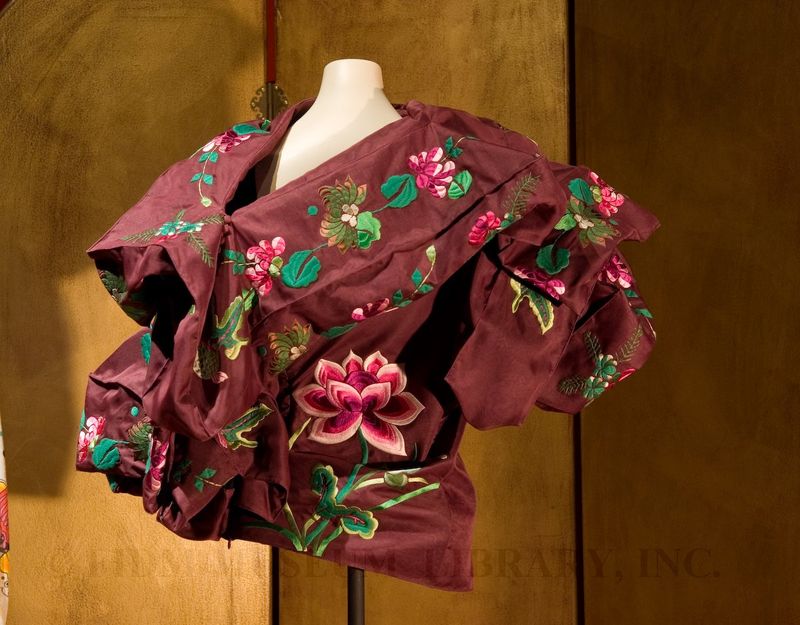For Western artists and designers, one of the most enduringly popular points of inspiration is “The Orient,” resulting in a style called “Orientalism.” In historical terms, the Orient was a broad geographical designation describing the many nations and cultures of Asia, Africa and the Middle East. To the Western mind, these cultures represented, “romance, exotic beings, haunting memories and landscapes, remarkable experiences.”1 Nations and cultures encompassed by this broad term may share some similarities, but each has distinct cultural and artistic traditions. Despite these differences, the Western mind has often grouped them into a unified whole. In design terms, this results in fantastic creations, the outcome of an exuberant and often naïve reinterpretation of non-Western cultures. Fashions inspired by Orientalism are often richly colored with intricate patterns or ornamental surface embellishments and present dramatic silhouettes.

“Nagasaki” Bodice (back view)
John Galliano for Christian Dior
Fall 2003 Ready-to-wear
FIDM Museum Purchase
2006.5.10
An Orientalist’s dream, this bodice features a tremendous mix of imagery and associations pulled from various parts of Asia. Nagasaki is a Japanese city, site of the second atomic bomb explosion in August 1945. The detonation of the “Fat Boy” bomb in Nagasaki killed as many as 80,000 people and led to Japan’s surrender in World War II. Perhaps Galliano named this bodice Nagasaki because it is an unruly garment, resembling an explosion of fabric. To see how this bodice looks on a human body, look at the runway images here.
The embroidered images of goldfish, lotus and peony-like flowers are reminiscent of Chinese embroidery motifs. Lotus flowers (the large pink/purple flower seen at the lower back) are associated with Buddhism, a religion found in many parts of Asia. The boxy sleeves and collar are shaped like the fragile paper lanterns often associated with Asia. Taking another view, the sleeves and collar resemble the folds of origami, which originated in Japan. Finally, the dark purple silk ground fabric is in a color called mulberry, a color Western minds have associated with East Asia (Japan, China, Korea) since the 19th century.
Was John Galliano aware of these varied associations when he designed Nagasaki? Probably, as just before this collection was presented, Galliano visited both Japan and China. Overall, his aesthetic often relies on heavy borrowing from non-Western cultures, as seen in this post.
Does this kind of borrowing result in more interesting design? Or does it lessen our ability to understand and appreciate other cultures for their unique qualities? Some might say (though hopefully not readers of this blog!) that it is merely fashion, with no additional importance.
1 Said, Edward. Orientalism (New York: Penguin, 2001) 1.


There’s lots of people (myself included) that are troubled by the use of terms such as ‘oriental’ which sweep together a huge mass of culturally diverse peoples and traditions into one catch-all word. Other offenders are ‘tribal’ and ‘ethnic,’ all terms that regularly appear in fashion-speak and are so broadly defined they are virtually meaningless. It speaks of white ‘western’ privilege (not to mention ignorance and insensitivity) and is immensely patronising and dismissive.
But I’m a Galliano fan, and he’s always picked and mixed his influences with breathtaking impunity. And I love how you have analysed this bodice – detailing the various elements so clearly.
Perhaps the decision to name this bodice ‘Nagasaki’ – a place synonymous with mass annihilation and therefore emotionally loaded – was insensitive. But who knows what Galliano’s intentions were. It might have been a sincere tribute or gesture of sympathy?
Galliano might have overstepped the mark (oops sorry!) last year with his shoes that featured heels shaped like Masai fertility symbols. Susan Scafidi does a great job on them here:
http://www.concurringopinions.com/archives/2008/10/spike_this_heel.html
Also, the blog Sociological Images has covered fashion’s blithe insensitivity to cultures outside the Euro-American zones of privilege. I’ll just pick two posts as examples:
http://contexts.org/socimages/2009/04/29/what-is-african-fashion/
http://contexts.org/socimages/2008/06/14/more-ethnic-fashion/
I look forward to a future where Chinese, African and Polynesian (or wherever) fashion designers will treat Euro-American cultures and traditions with the same lack of respect, and sell them back to us!
We’ve lost a lot by having a Western world culture that dresses in jeans and t-shirts. Having people dress in the traditional national clothing of each country would make the world a lot brighter 🙂
I find this supremely insensitive to call it “Nagasaki” from an American designer. Perhaps you could get away with that by itself, or the “Oriental” slip, but both together, without input from a Japanese stylist in the creation and… well… My first thought upon reading the “Unruly” look and “Explosion” of colour made me wonder if we would accept such description were an ethnic German to design a dress based on ashes and gas and call it “Dachau”.
I suspect not. I couldn’t even breath for a couple minutes after reading that I was so horrified.